The Flexographic print process has long been thought of as a simple print process, not capable of the same quality as the lithographic print process. In the last five years there have been many advances in plate technology, digital platemaking process, and screening that have dramatically improved the quality of Flexo. It is very common today for converters to run 150 lpi, and many have made the jump to 175 or 200 lpi along with the ability to fade screen vignettes to zero. These specifications would have been virtually impossible a few short years ago.
Is ECG Just the Latest Trend?
The ability to print fine screen rulings and fade screen vignettes to zero have made a resurrected technology possible, printing with an Expanded Color Gamut (ECG). ECG printing has been around for quite some time. The Lithographic industry has been using it, in limited areas, since the early 1990’s. Matter of fact, in an article written by Don Hutcheson for the 1999 GATF Technology Forecast (www.hutchcolor.com/PDF/HiFiupdate98_2000_04.pdf) the following Extended Gamut systems (then called HiFi Color) were commercially available in 1998:- Hexachrome (CMYK+OG) - Pantone
- MaxCYM (CMYK+CMYK) – Royal Zenith and then the basis for DuPont’s HyperColor
- Opaltone (CMYK+RGB)
Why Are We Talking About it Now?
So, if the technology has been around for so long, why is everyone in Flexo just now talking about it? The main reason is the ability to reproduce a majority of spot or Pantone colors using only 7 inks, CMYK+OGV. This has recently been demonstrated with the 2014 & 2105 fall covers of FLEXO Magazine.
Last October the front cover was printed Flexo using 7/color ECG and the back cover was also printed Flexo using standard 4/color process. The color difference and Pantone color match was amazing using the 7/color ECG process.
The 2015 November cover of FLEXO Magazine was again printed using the 7/color ECG process but this time it was compared to a 4/color cover printed using litho.
Award-winning connections
We (APR) were lucky enough to be involved in both projects. Earlier this year Gidue (now Bobst) was notified that they had won the 2015 FTA Technical Innovation Award. The award was presented to Gidue at the FTA Forum/InfoFlex in May.
The FTA asked Gidue if they would like to participate in printing the November cover of FLEXO Magazine using the Gidue M5 Digital Flexo Excellence Press located at the APR Technology Center (located in Glendale Heights, IL), along with the 2014 FTA Technical Innovation Award Winners, Esko Equinox and SpotOn! Flexo. Gidue agreed and project planning began. The goal of this project was to demonstrate the quality of 7/color ECG printing versus normal 4/color process printed litho.
Putting it all together
In August, APR hosted 12 industry-invited personnel, plus a few of us at APR, to print from scratch, the November cover of the FLEXO Magazine. This meant we needed to Optimize, Fingerprint and Characterize the Gidue press prior to actually printing the cover. This process required 4 press runs and 16 plates before we had the proper information to create the profile and the final 7 plates required for the cover. The process is intense but the results are amazing.
Below is an example of the 4/color Litho cover versus the 7/color ECG Flexo cover printed at APR.
You can see how vibrant and colorful the 7/color ECG cover is compared to the normal 4/color cover. Also note the Purple in the FLEXO masthead, as well as, the green and yellow side bars. These areas are spot colors that would normally have to be run in their own print station but with 7/color ECG process you can reproduce these and virtually any other color.
The November FLEXO Magazine debuted November 3, 2015 at the FTA Fall Conference in Columbus, OH. The following link will direct you to the electronic version of the 12-page article that appears in the magazine.
http://digital.realviewtechnologies.com/?xml=Flexo&iid=130688#folio=17These two magazine covers demonstrate that the 7/color ECG process is viable and the products/technologies required for this process are commercially available.
Industry-wide acceptance of Expanded Color Gamut
Another major step forward in the acceptance of the 7/color ECG process happened in September when Pantone announced a new Pantone® Plus Series Extended Gamut Coated Guide printed using the 7/color ECG process. www.pantone.com/what-is-extended-gamut
For years we (the printing industry) have shown content creators and designers the Pantone Plus Series Formula Guide®, and said you can pick any 2 or 3 of these colors, that we would run as a special or spot color. With the new Extended Gamut Color guide, content creators and designers can pick as many of these color as they want!
Hands-on experience with Expanded Color Gamut Printing
Earlier this year, Esko and APR held an Expanded Gamut class where we produced a series of labels printed on the Gidue M5 press using 200 lpi and Esko’s Full HD Flexo & Equinox technologies both in 4/color process and 7/color ECG.
The results were amazing. The 7/color ECG labels faithfully reproduced all 15, yes 15 Pantone colors. So imagine if this was a commercial job and the customer asked you for a label with 15 Pantone colors, what would you do? It's not IF ECG will become the standard for Flexo printing it's WHEN, and the when is quickly becoming now!
Kind of makes you scratch your head, doesn’t it? 😉
For more info about Esko HD Flexo, click here: Esko HD Flexo - A New Standard for Flexo.

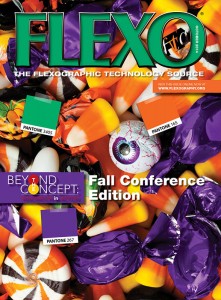
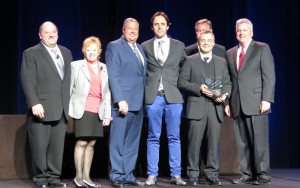
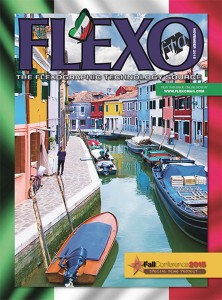
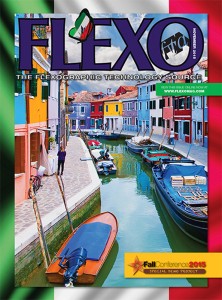
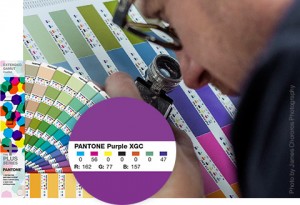
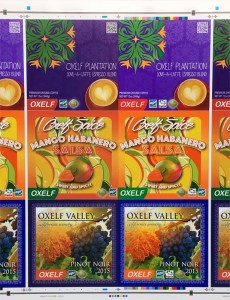
One thought on “Flexo’s Future – Expanded Color Gamut”